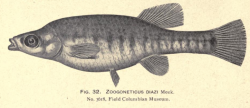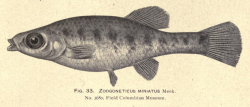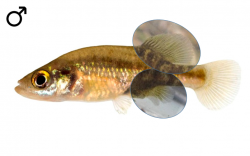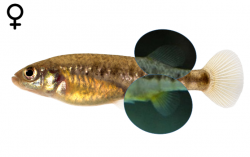- HOME
- WHO WE ARE
- NEWS AND DATES
- GOODEIDS
- PHYLOGENY
- ARTIFICIAL KEY
- GOODEID SPECIES
- BIOLOGY
- ENVIRONMENT
- CONSERVATION
- PROFUNDULIDS
- MEMBERS AREA
Allotoca diazi
English Name:
Pátzcuaro Allotoca
Mexican Name:
Chorumo
Original Description:
MEEK, S. E. (1902): A contribution to the ichthyology of Mexico. Publication. Field Columbian Museum 65, Zoological Series. 3 (6): pp 63-128
Holotype:
Collection-number: Field Columbian Museum, Cat. No. FMNH-3618.
The Holotype is an adult female of 66mm standard length, collected together with others by S. E. Meek and F. E. Lutz in the period of May the18th to the 22nd, 1901. Specimens they collected from the Zirahuén lake on May the 24th belong now to Allotoca meeki. Another species, now synonymized with diazi, Zoogoneticus miniatus, was described by Meek after five specimens in poor condition, traced back by him to a collection of him and Lutz from the Chalco lake, Mexico City, on April 30th. This location is correctly regarded as a mistake. The Cat. No. of the Holotype of this fish is FMNH-3680. There is also an entry about 12 specimens of Skiffia variegata (now lermae) from Chalco by the same collectors, which has also to be regarded as a mistake (FMNH-3679)
Paintings of the Holotype of Allotoca diazi (left) and of the Holotype of Zoogoneticus miniatus, a synonym of Allotoca diazi (right):
Terra typica:
The Holotype was collected in the Pátzcuaro lake in Michoacán.
Etymology:
Meek named the species for José de la Cruz Porfirio Díaz, President of the Republic of Mexico from 1876/77-1880, and again from 1884-1911.
The genus Allotoca was erected by Hubbs and Turner, published by Turner in 1937 and taken from the manuscript of the famous monography about Goodeids that Hubbs & Turner finally published together in 1939. Though the authors mentioned the posterior insertion of the dorsal fin, "the more fundamental characters of Allotoca, however, are ovarian and trophotenial..." The word ἄλλος (állos) means different and τόκος (tókos) offspring, so the genus refers to the different looking trophotaenia of the fry with the generic name meaning "different offspring".
Synonyms:
Zoogoneticus diazi Meek, 1902
Zoogoneticus miniatus Meek, 1902
Neoophorus diazi Hubbs & Turner, 1939 (partially)
Distribution and ESU's:
The Pátzcuaro Allotoca is endemic to the Mexican federal state of Michoacán where it occurs in the endorheic Lago de Pátzcuaro drainage. Historically known from the lake itself and some of its tributaries, it now seems to be extirpated from the Lago de Pátzcuaro (Corona-Santiago, 2015; Zambrano et al., 2014) and is known from only three collection sites along the Canal la Ciénega, mainly from the main spring at the old mill at Chapultepec (Molino Viejo de Chapultepec). This species is restricted to the Pátzcuaro lake basin with no recognized subpopulations. The bold names are the ones officially used by the Instituto Nacional de Estadística y Geografía; nevertheless, other ones might be more often in use or better known and therefore prefered.
ESU ist short for Evolutionarily Significant Unit. Each unit expresses an isolated population with different genetic characteristics within one species. ESU's can be defined by Molecular genetics, Morphology and/or Zoogeography and help in indicating different phylogenetic lineages within a species. The abbreviation for an ESU is composed of three letters of the genus, followed by the first two letters of the species name and an ongoing number in each species.
All populations of Allotoca diazi belong to one ESU: Altdi1.
The left map shows the Lago de Pátzcuaro-Cuitzeo y Lago de Yuriria basin from the Hydrographic Region Lerma-Santiago on a Mexico map, the right one the Lago de Pátzcuaro subbasin (PAT) within the Lago de Pátzcuaro-Cuitzeo y Lago de Yuriria basin, where the Pátzcuaro Allotoca exclusively occurs:
Status :
International Union for Conservation of Nature (IUCN): Critically Endangered
Distribution and current conservation status of the Mexican Goodeidae (Lyons et al., 2019): Critically Endangered/declining: „Older literature (e.g., Meek, 1904; Mendoza, 1962) placed this species in the genus Neoophorus, but recent morphological and genetic analyses indicate that Allotoca is more appropriate (Meyer et al., 2001; Doadrio and Domínguez-Domínguez, 2004; Webb et al., 2004). Currently, A. diazi is known from just three small areas in the Lake Pátzcuaro basin, the only basin where it occurs. It has declined dramatically in Lake Pátzcuaro proper and persists only as a remnant population there. The largest remaining population is in the Molino de Chapultepec Springs near the town of Pátzcuaro.“
NOM-059-SEMARNAT-2010: Categoría de riesgo (Category of risk): P - En Peligro de Extinción (in danger of extinction)
Habitat:
This fish can be found in lakes, spring-fed creeks and ponds in clear to muddy water, the currents are none to moderate. The substrates in the habitats are mainly mud, sand and rocks and the vegetation includes species of Potamogeton, Myriophyllum, Eichhornia, Lemna, Chara and green algae. Like most Goodeid-species, Allotoca diazi prefers depths of less than 1m.
The Pátzcuaro Allotoca was found on several surveys of the GWG from 2014 to 2017 in both effluents of the spring at Chapultepec, channels from about 80cm (southern-channel) to more than 1m (western-channel) width. The channels had sandy ground with gravel and several rocks on the borders. Submerse vegetation was present in form of some floating water hyacinths directly after the outlet in the south and areas with dense stocks of Egeria. Grassy riparian vegetation covered the borders and hang over the surface, the western channel was partly covered by trees. At the western outlet, some exotic Zantedeschia sp. grew along with the borders and shaded it partly. This part of the channel was densely planted with Egeria and deep to 1m. After 120m from the outlet, it was dammed, leaving the subsequent part of the channel with a varying depth between 15 and 40cm. The current in both channels was fast to moderate, the water looked characteristic milky blue, probably due to some solved minerals. The vegetation in the spring itself was composed of Egeria sp. and Potamogeton sp. The water parametres taken in March 2017 were: Water temperature; 19.5°C, pH: 7.22, conductivity: 1,180μS; other fish species associated were Alloophorus robustus, Goodea atripinnis, Skiffia lermae, Allotoca dugesii and Algansea lacustris.
Biology:
G. Mendoza (1962) studied ovaries of three Goodeid species from the Pátzcuaro lake, including Allotoca diazi. Following his results, diazi has got a gestation-length of 60-75 days. He found young fish continously from April to January (extending over 8 or 9 months), so this could be caused by a single brood with females starting at different times or by multiple cycles. The average brood size has been 39.9 young per ovary with Embryos having all nearly the same size. Runts comprised only 0.49%. He believed that diazi matures in the first year. One female of 75mm SL collected in May 1901 by Meek contained 28 young, each about 15mm long. Another female of about 80mm contained 47 young fish, each of them about 10mm in length.
Diet:
Following Kingston (1979), the Pátzcuaro Allotoca is primarily carnivorous and hunts for insects at the water surface and accepts worms at bait. The gut is short, about as long as the body, the teeth are very large and conical and the mouth is rather large and protractile. This all are indications of carnivorous feeding habits.
Size:
The maximum known standard length is about 120mm (Miller et al., 2005).
Colouration:
The fish are cryptically coloured. Meek described the colouration as "light olivaceous, much mottled with darker, which forms irregular cross bars on the sides; many of the larger specimens in life with a reddish tinge over the body, which fades to nearly a uniform light olive; fins all plain. The males are a little duller and of a more uniform colour than are the females." Concerning Zoogoneticus miniatus (the same species, Meek described it in the same paper immediately after diazi), he wrote: "Olivaceous, much mottled with darker. No distinct lateral band. The last blotch forms an indistinct black caudal spot." Nevertheless, the black bars and black spots in the midline between them form an indistinct lateral band. The belly is not spotted, the dorsal part of the body speckled.
Sexual Dimorphism:
At first appearance, males and females of the Pátzcuaro Allotoca are not very easy to distinguish. The safest characteristic is the Splitfin in males, means the for Goodeinae typical mating organ formed by a notch after the first seven shortened rays of the Anal fin. Additionally, male Allotoca diazi have a bigger Dorsal fin than females. A difference in colouration is almost not visible, except for a yellow base of the Anal fin in females. Females are a bit longer than males with a slightly bigger and blunt head, but some experience is necessary to see these characters.
Remarks:
Meek's record from "Chalco, Valley de México" (1902, as Zoogoneticus miniatus) is regarded as an error for another locality of the same name near La Palma, Michoacán (Álvarez del Villar & Narrasco, 1957). It has been described after a small female of 40mm (about 1.6 inches) "closely resembling Skiffia lermae (in the description Skiffia variegata, a synonym) in general colour and form."
The Pátzcuaro Allotoca occurs sympatrically with another species from its genus, Allotoca dugesii. This is one of only four pairs of Goodeid species from the same genus, that cooccur and don't produce hybrids. The other pairs are "Xenotoca" melanosoma and lyonsi, the undescribed "Xenotoca" cf. melanosoma and doadrioi and Zoogoneticus tequila that coexists with purhepechus.
As a reaction on the threats this species is facing, the Austrian Association of Aquarists (ÖVVÖ) started a Studbook on this and all other Allotoca species (including the closely related Neoophorus regalis).
There exist samples from an Allotoca diazi like species from the endorheic Lago de Cuitzeo basin, more precisely from the La Mintzita spring and the Presa de Cointzio, sometimes refered to as Allotoca diazi. Unfortunately all of these are historic records, so we haven't found any similar looking species in the last decades, and it is also not clear, if these samplings were really made in the area and if yes, which species they belong to.
Husbandry:
Looking on the biotopes of Allotoca diazi, they suggest the species may prefer a habitat with moderate to swift current, structured with gravel, rocks, roots, branches, fallen leaves and river bank vegetation. Fry is eaten in some cases, but it may depend on the quantity and quality of food and on the number of places to hide. When several different stages of juveniles occur, fry may be neglected, so it makes sense to add separate brought up fry to the group with a size of 1.5 or 2cm to provide these stages and get a flock breeding colony.
The recommended tank size is at least 100 liters, bigger tanks with a generous base and little height (25cm are enough) are better for sure. With rocks and vegetation in the corners and backsinde of the tank well structured tanks combined with some roots and/or wood seem to do best with this species. The current should be moderate or swift, especially as the species is adapted to a high oxygene level (at least 8mg/l).
In the wild, the species feeds mainly from small or middle-sized invertebrates like bloodworms or insect larvae, so feeding with similar food, water fleas, Mysids and other food from animalistic sources will be best for this predatory fish. In aquarium, it feeds also well from flake food, granulate and even tablets, additionally given Nauplia of Brine Shrimps are eaten greedy. The species is not really shy, but likes to use hiding spots to observe the surrounding.
Concerning water quality, this species is in need of bigger water changes (60-80% every week) like most of the Goodeids, especially river and spring inhabiting species, so an automatic water changing system can be helpful. Otherwise, in combination with constant temperatures higher than 24°C, fish may get sick, lose resistance against diseases and age too fast. So for keeping the strain healthy and strong, give the fish a rest during winter time with temperatures lower than 20°C for 2 or 3 months so they stop producing fry. Allotoca species can be kept down to temperatures of 15 or 16°C without problems for months, some species even lower. In spring, when the temperature slowly increases, they will start spawning at 20 or 21°C and won't stop until it gets colder again or when it gets too warm (25°C).
This species is doing very well when is kept in the open from spring to fall, starting when the water temperature by day exceeds 15°C and cold periods are no longer expected. Bring them out in the early afternoon, the time of the day with the highest water temperature. During the warm summer, reproduction will stop and may occur again in fall. Bring the fish in before the water temperature deceeds 15°C by day and keep them cool for the first days, then slowly raise the temperature but try to stay below 20°C over the winter time.
Populations in holding:
Here each species are assigned populations of fish in husbandry and in brackets aliases of these locations to assist in identifying own stocks. Each population is assigned a unique Population-ID, composed by the ESU, the subbasin where this population is occurring (three capital letters) and a unique location identifier.
Populations in holding:
1. Altdi1-PAT-RMol
Population: Rancho El Molino (aka Molino Viejo de Chapultepec)
Hydrographic region: Lerma-Santiago
Basin: Lago de Pátzcuaro-Cuitzeo y Laguna de Yuriría
Subbasin: Lago de Pátzcuaro
Locality: spring at the old mill (Molino Viejo) of Chapultepec













